The Infamous 900-series
The bigger Pro-Line models do not have a really good
reputation. Many consider these much too bulky and generally troublesome,
although a fully working specimen of model 900/910/925 will knock your socks
off.
The 900-series consisted of five different model designations: 900, 900U, 910, 925 and 950, though the 950 is not really comparable to any other Leslie model in existence. A brief outline of the models can be found in the table below:
| Model | Speaker configuration | Weight | Output power, total (watts) | Special features | Notes |
| 900 | Horn/treble driver, rotor/15" bass, two 6x9 reverb speakers | 75kg (top 48kg) | 100 | Reverb | No slow speed on bass rotor |
| 900U | Reverb | Same speaker as model 900 but in a 'utility' cabinet | |||
| 910 | 100 | Reverb | Replaced model 900 | ||
| 925 | Horn/treble driver (high power), rotor/15" bass, four 6x9 stationary speakers | 97kg (top 39kg) | 140 | Extra speakers can be 'dialled in' for more power | The speakers in this model are not found in other Leslie cabinets |
| 950 | Four 12" full range speakers each with a vertical rotor | 190kg | 200 | Blacklight effects | Special showman model. Extremely rare, heavy and not well suited for Hammond organs |
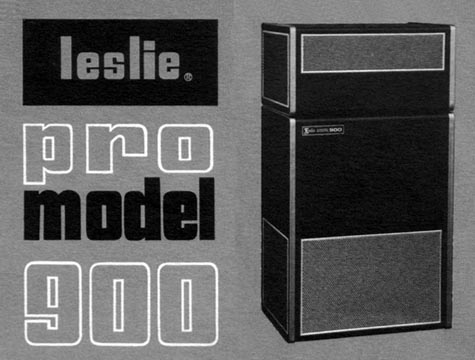
The first model,
model Pro 900, was also the first Pro-line model ever. It had a two-piece cabinet
(complete top horn assembly in separate box) and built-in reverb. The solid state
amplifier produced 100W all in all, pretty loud for the time. For some reason the 900
didn't have the slow speed for the bottom rotor. The reverb channel sounded
through two 6x9" speakers in the top part of the cabinet. The reverb
sound itself was treated with a tremolo effect to keep it in sync with the
rotor signal. This effect was accomplished with a so-called space
generator, a variable air capacitor similar to the Hammond vibrato
scanner. The shaft of this capacitor was coupled to the drive belt on the
top horn - see the photo below.
(Leslie 900 graphic kindly donated by Les Lacy)
The concept of the two-piece cabinet was the same for the following two models. The top half of the speaker was connected to the bottom half with two cables - one for audio signals, one for motor power.
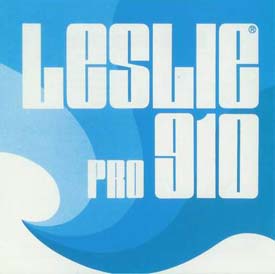

Leslie 910. Photo kindly supplied by
Geoff Williamson in Austraila
The 900 was replaced by model 910 that had the same features but was improved in design and durability.
All of the 900-series Leslies had the early 9pin hook-up. They could be mated with guitars and other kinds of instruments with the Combo Preamp DeLuxe - essentially a Combo Preamp II with additional control buttons for the stationary channel (see the special page on the Combo Preamps).
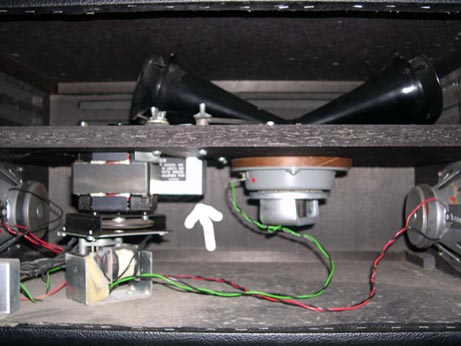
The top cabinet of Geoff's Leslie
910. Note the 'space generator' capacitor.
Model 900 and 910 both had two reverb speakers on the sides, as pictured.
Model 925 also had these two speakers plus an additional two on the front
baffle. This makes it easy to distinguish the 925 from the other two
models as the top front grille cloth covers the entire front and not just
the top half (see the photo on the left).

The more successful model in the 900-series was the Pro 925. It had a
total of 140W amplifier output and better speakers (JBL) and is considered
to be the loudest Leslie of all. It had no built-in reverb, but had a
separate dry channel with four 6x9" speakers that could be turned on for
extra volume. There was no separate input for the 'dry' channel.
The 925 was almost 50% more expensive than the 900 and 910 - even if it
did not have the reverb. With an unprecedented 50W power for the treble
horn alone and a special design high power driver, it is easy to
understand why the 925 is considered the loudest of the bunch.
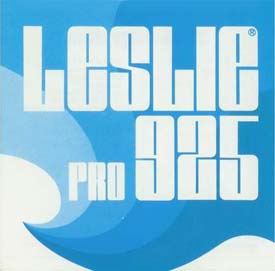
(Thanks to Zsolt for the 910 & 925
brochures)
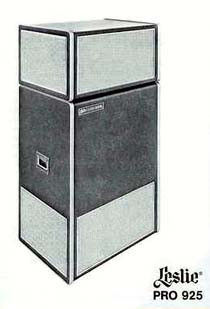
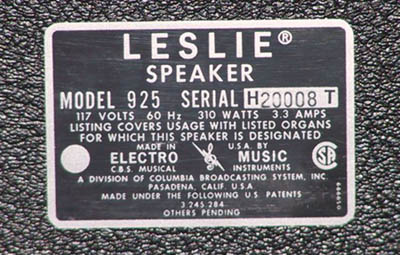
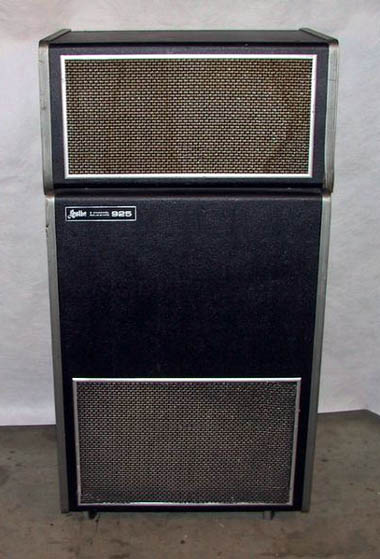
The grille cloths have seen better days.
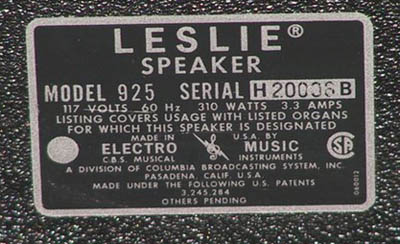
Model 950
For the record the special model 950 should be
mentioned. Probably the heaviest Leslie (~ 400lbs) built and IMHO one of the ugliest. I'll
scan a picture of it soon. The rotor system consisted of four individual foam rotors a la
the Leslie OEM units for spinet organs. Each rotor had its own 12" speaker powered
with a 50W solid state amp. The rotors were mounted vertically in a column and they were
visible. Each rotor also had a psychedelic pattern painted on it - made to look exciting
when the rotors spun and to top it off, there were built-in black lights in the cabinet
making the rotor patterns glow by themselves. (Very psychedelic!). All of the fun could be
controlled from a Combo Preamp DeLuxe.